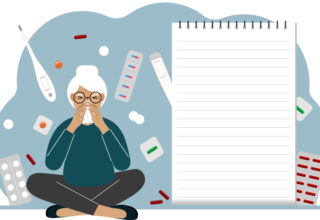We all worry. It’s part of being a human. It may be about finances, work, health, or family. But for some people that worry doesn’t go away— it lingers, grows, and feels overwhelming, even when there is no obvious reason for it. If it sounds familiar, it might be something more than everyday stress. It might be Generalised Anxiety Disorder (GAD).
Let’s explore what generalised anxiety disorder really is, what it feels like, why it happens, and how it can be managed and treated.
What is Generalised Anxiety Disorder (GAD)?
GAD is a common mental health condition where you often feel excessive worry or anxiety about different everyday things, for a long period of time. This constant worry can interfere with your daily life— work, relationships, sleep, and even physical health.
These feelings are often uncontrollable, and the person who feels them is usually aware that their anxiety is out of proportion— like thinking of doing everyday tasks can make them feel uneasy and overwhelmed. People with GAD often describe this feeling like their mind just won’t shut off.
Symptoms of Generalised Anxiety Disorder:
Symptoms of GAD are similar to those of other anxiety disorders. However, everyone may experience different symptoms. Here are some common ones:
Physical Symptoms:
- Palpitations (awareness of your heart beating faster than usual)
- Shortness of breath
- Muscle pains
- Fatigue
- Trembling
- Sweating
- Headaches
- Choking sensations
- Restlessness
- Trouble concentrating
- Easily startled
- Dizziness
- Stomach issues like nausea and diarrhea
- Sleep disturbances
Psychological symptoms:
- Excessive worry about things
- Trouble focusing
- Feeling “on the edge”
- Irritability
- Difficulty falling or staying asleep
- A constant feeling that something terrible is about to happen
- Fear of making bad decisions
- Focusing on the negative outcomes when making a decision
The symptoms of GAD may look like other mental health conditions. Always consult a doctor for diagnosis.
Causes of GAD:
Like many other mental health conditions, there is no one obvious cause. It may develop from a mix of factors like:
- Biological: Genetics plays a role. If anxiety runs in your family, you might be more likely to experience it too.
- Brain chemistry: Imbalances in neurotransmitters like serotonin and dopamine might contribute.
- Life experiences: Traumatic or stressful life events, especially in childhood, also shapes the way you react to everyday situations.
- Personality: some people are naturally more prone to worry and perfectionism.
GAD can start at any age, but it often begins in childhood or early adulthood. It can develop gradually which makes it easy to overlook at first.
Risk Factors for GAD:
GAD can affect anyone but you might be more at risk of developing it if you:
- Are female, as GAD is more common in women than in men
- Have a family member who has been diagnosed with GAD
- Have experienced a traumatic event in your life
- Have chronic stress
- Have any other mental health condition like panic attacks, depression, or phobia
- Have a chronic illness like chronic pain or heart disease
- Use any substance like tobacco, alcohol, or marijuana
How is GAD Diagnosed?
A healthcare or mental health professional can diagnose GAD by evaluating your symptoms and checking if they might be related to any other condition.
Your doctor will use a criteria in the Diagnostic and Statistical Manual of Mental Disorders, fifth edition (DSM-5). A key part of diagnosis is experiencing excessive worry on most days for at least six months— worry that’s hard to control.
Along with anxiety, adults usually have three of these symptoms (children need just one):
- Restlessness or feeling on the edge
- Getting easily tired
- Trouble focusing or blank mind
- Irritability
- Muscle tension
- Sleep problems like difficulty falling or staying asleep or unrestful sleep
These symptoms must interfere with daily life— affecting things like work, relationships, or overall well-being.
Before confirming the diagnosis, your doctor will rule out other possible causes, such as medication side effects, or other mental health conditions like panic disorder, social anxiety, or PTSD.
Management and Treatment:
The good news is, there is treatment available for GAD that can help you manage your symptoms. But you have to be patient as it takes time.
1. Lifestyle Support:
Here are a few lifestyle changes you can try to manage your symptoms of anxiety:
- Doing regular exercise like walking, swimming, or cycling can significantly reduce anxiety.
- Get adequate sleep. Good rest helps your body and mind to reset.
- Limit intake of caffeine and alcohol. Both of these can worsen the symptoms of anxiety.
- Practice relaxation techniques like deep breathing, meditation, and yoga can help calm yourself and reduce stress and anxiety.
- Seek support from your friends, family, or support groups. They’ll give a space to share your experiences, learn from others, and get encouragement while you’re managing GAD.
You can also try other natural ways to cope with your anxiety.
2. Psychotherapy:
It is also known as talk therapy. Talking to a mental health professional in a safe, supportive space can help you better understand your thoughts, emotions, and behaviors.
One of the most effective treatments for GAD is Cognitive Behavioral Therapy (CBT). It teaches you how to recognise and shift your focus from negative thought patterns that fuel your anxiety. Over time, CBT can reduce excessive worry and help you build healthier coping skills.
3. Medications:
In some cases, medication may also be a part of your treatment plan. Your healthcare provider may prescribe you medications like:
- Selective serotonin reuptake inhibitors (SSRIs)
- Serotonin norepinephrine reuptake inhibitors (SNRIs)
- Benzodiazepines (only for short-term)
- Buspirone
If you don’t respond to these, your doctor may recommend some other medications, depending on your condition.
When to See a Doctor:
- If you feel like your anxiety is always there, just like a background noise that you can’t turn off, and it is affecting your daily life, then you should see a doctor.
- If you’re taking medications for GAD, make sure to check in with your doctor regularly. They’ll monitor how the medications are working and if necessary, make any adjustments. Be open about any side effects or changes in how you’re feeling.
- Most importantly, if you’re ever feeling overwhelmed or thinking about harming yourself, don’t keep it to yourself. Reach out to your healthcare provider right away.
Remember, help is always available.
Learn here about when to seek help for anxiety.
Help and Support for GAD:
If you’re finding help and support for GAD, your GP can be a great first point of contact.
They can offer you guidance and connect you with local support services that might be helpful.
You can also reach out to the national and local organisations like Grow Mental Health. This organisation can provide valuable information and support to anyone struggling with GAD.
You can also find online or local support groups for yourself or anyone affected with GAD.
How to find a support group (Mind)
How to find a support group in your area (Rethink Mental Illness)
Final Thoughts:
Generalised anxiety disorder is not just “over thinking”. It’s a real and often exhausting condition— but it is also manageable. Understanding it is the first step towards regaining control.
If you or someone you care about is living with GAD, know that support is out there. With time, patience, and the right approach, that constant cloud of worry can begin to lift.








